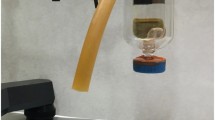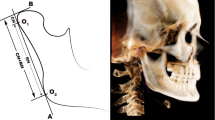Abstract
Objectives
The aim of this study is to research the mandibular condyle volumes of the Turkish subpopulation by sex, age, laterality, and posterior occlusal support, to provide volumetric data for young and old patient groups.
Methods
The CBCT images of 690 condyles from 345 patients (165 females and 180 males) were assessed. Patients aged 18–25 years were chosen for the younger group, and 45–70 years for the older group. The dental statuses of the older patient group were divided into three categories, based on the Eichner index. All the CBCT images were transferred to the three-dimensional volumetric analysis software, ITK-Snap (Penn Image Computing and Science Laboratory (PICSL) at the University of Pennsylvania and Scientific Computing and Imaging Institute (SCI) at the University of Utah) and analyzed with sagittal, coronal, and axial sections. Mandibular condyles were defined using semi-automatic segmentation, then manual segmentation was performed to ensure accuracy. Analyses were performed using MedCalc statistical software. The p value < 0.05 was considered statistically significant.
Results
The mean right condyle volume for the whole sample (n = 345) was 1678.8 mm3 and the left condyle volume was 1661.3 mm3. Males had a larger condyle volume than females in both the younger and older patient groups (p = 0.035, p < 0.01, respectively). The Eichner index did not correlate significantly with condylar volume in the older patient group (p = 0.134, p = 0.122).
Conclusion
There were significant differences between the volumes of mandibular condyles for different sex, while there were no significant differences in relation to age, laterality, and posterior occlusal support.


Similar content being viewed by others
References
Okeson JP. Management of temporomandibular disorders and occlusion. St Louis: Elsevier/Mosby; 2013.
Ishibashi H, Takenoshita Y, Ishibashi K, Oka M. Age-related changes in the human mandibular condyle: a morphologic, radiologic, and histologic study. J Oral Maxillofac Surg. 1995;53:1016–23.
Safi A-F, Kauke M, Grandoch A, Nickenig H-J, Zöller JE, Kreppel M. Age-related volumetric changes in mandibular condyles. J Craniofac Surg. 2018;29:510–3.
Saccucci M, Polimeni A, Festa F, Tecco S. Do skeletal cephalometric characteristics correlate with condylar volume, surface and shape? A 3D analysis. Head Face Med. 2012;8:15.
Ahn SJ, Chang MS, Choi JH, Yang IH, An JS, Heo MS. Relationships between temporomandibular joint disk displacements and condylar volume. Oral Surg Oral Med Oral Pathol Oral Radiol. 2018;125:192–8.
da Silva RJ, Valadares Souza CV, Souza GA, Ambrosano GMB, Freitas DQ, San’Atana E, et al. Changes in condylar volume and joint spaces after orthognathic surgery. Int J Oral Maxillofac Surg. 2018;47:511–7.
Boulétreau P, Frey R, Breton P, Freidel M. Focus on the effect of orthognathic surgery on condylar remodeling. Rev Stomatol Chir Maxillofac. 2004;105:283–8.
Conte R, Forin Valvecchi F, Gracco AL, Bruno G, de Stefani A. Condylar dysfunctional remodeling and recortication: a case-control study. Minerva Stomatol. 2019;68:74–83.
Chen J, Sobue T, Utreja A, Kalajzic Z, Xu M, Kilts T, et al. Sex differences in chondrocyte maturation in the mandibular condyle from a decreased occlusal loading model. Calcif Tissue Int. 2011;89:123–9.
Nascimento Falcão I, Cal Alonso MBC, da Silva LH, Lopes SLPC, Comar LP, Costa ALF. 3D morphology analysis of TMJ articular eminence in magnetic resonance imaging. Int J Dent. 2017;2017:5130241. https://doi.org/10.1155/2017/5130241.
Tecco S, Saccucci M, Nucera R, Polimeni A, Pagnoni M, Cordasco G, et al. Condylar volume and surface in Caucasian young adult subjects. BMC Med Imaging. 2010;10:28.
Saccucci M, D’Attilio M, Rodolfino D, Festa F, Polimeni A, Tecco S. Condylar volume and condylar area in class I, class II and class III young adult subjects. Head Face Med. 2012;8:34.
Enomoto A, Watahiki J, Yamaguchi T, Irie T, Tachikawa T, Maki K. Effects of mastication on mandibular growth evaluated by microcomputed tomography. Eur J Orthod. 2010;32:66–70.
Paknahad M, Shahidi S, Akhlaghian M, Abolvardi M. Is mandibular fossa morphology and articular eminence inclination associated with temporomandibular dysfunction? J Dent (Shiraz, Iran). 2016;17:134–41.
Bayram M, Kayipmaz S, Sezgin ÖS, Küçük M. Volumetric analysis of the mandibular condyle using cone beam computed tomography. Eur J Radiol. 2012;81:1812–6.
Gibelli D, Cellina M, Gibelli S, Cappella A, Panzeri MM, Oliva AG, et al. Anatomy of the pterygopalatine fossa: an innovative metrical assessment based on 3D segmentation on head CT-scan. Surg Radiol Anat. 2018;41(5):523–8.
Vallaeys K, Kacem A, Legoux H, Le Tenier M, Hamitouche C, Arbab-Chirani R. 3D dento-maxillary osteolytic lesion and active contour segmentation pilot study in CBCT: semi-automatic vs manual methods. Dentomaxillofac Radiol. 2015;44:20150079.
Yushkevich PA, Piven J, Hazlett HC, Smith RG, Ho S, Gee JC, et al. User-guided 3D active contour segmentation of anatomical structures: significantly improved efficiency and reliability. Neuroimage. 2006;31:1116–28.
Nota A, Caruso S, Ehsani S, Baldini A, Tecco S. Three-dimensional volumetric analysis of mandibular condyle changes in growing subjects: a retrospective cross-sectional study. Cranio. 2018. https://doi.org/10.1080/08869634.2018.1537088.
Goulart DR, Muñoz P, Cantín López MG, de Moraes M, Olate S. Comparative evaluation of condylar volume between patients with unilateral condylar hyperplasia and class III dentofacial deformity. J Oral Maxillofac Surg. 2017;75:180–8.
Alexiou K, Stamatakis H, Tsiklakis K. Evaluation of the severity of temporomandibular joint osteoarthritic changes related to age using cone beam computed tomography. Dentomaxillofac Radiol. 2009;38:141–7.
Li G, Qian H, Guo S, Wang D, Sun C, Du Y, et al. Assessment of aging characteristics of female condylar trabecular structure by cone-beam computed tomography. Oral Radiol. 2019;35:16–22.
Al-Koshab M, Nambiar P, John J. Assessment of condyle and glenoid fossa morphology using CBCT in south-east Asians. PLoS ONE. 2015;10(3):e0121682.
Ueki K, Nakagawa K, Takatsuka S, Yamamoto E, Laskin D. Comparison of the stress direction on the TMJ in patients with class I, II, and III skeletal relationships. Orthod Craniofac Res. 2008;11:43–50.
Ahmed NF, Samir SM, Ashmawy MS, Farid MM. Cone beam computed tomographic assessment of mandibular condyle in Kennedy class I patients. Oral Radiol. 2019. https://doi.org/10.1007/s11282-019-00413-1.
Giesen EBW, Ding M, Dalstra M, van Eijden TMGJ. Changed morphology and mechanical properties of cancellous bone in the mandibular condyles of edentate people. J Dent Res. 2004;83:255–9.
Levartovsky S, Gavish A, Nagar Y, Sarphati L, Levartovsky D, Winocur E. The association between dental status and temporomandibular osseous changes: a morphological study on Roman–Byzantine skeletons. J Oral Rehabil. 2012;39:888–95.
Eichner K. Uber eine Gruppeneinteilung der Lunckengebisse fur die Prothetic. Dtsch Zahnarztl Z. 1955;10:1831–4.
Widmalm SE, Westesson P-L, Kim I-K, Pereira FJ, Lundh H, Tasaki MM. Temporomandibular joint pathosis related to sex, age, and dentition in autopsy material. Oral Surg Oral Med Oral Pathol. 1994;78:416–25.
Funding
The study was self-funded by the authors.
Author information
Authors and Affiliations
Contributions
GAŞ conceptualized and designed the study, acquired, interpreted the data, drafted the manuscript, and revised the paper. ZÖ contributed to the data collection and interpreted the data.
Corresponding author
Ethics declarations
Conflict of interest
Gülay Altan Şallı and Zeynep Öztürkmen declared that they have no conflict of interest.
Ethical Approval
All procedures followed were in accordance with the ethical standards of the responsible committee on human experimentation (institutional and national) and with the Helsinki Declaration of 1964 and later versions.
Additional information
Publisher's Note
Springer Nature remains neutral with regard to jurisdictional claims in published maps and institutional affiliations.
Rights and permissions
About this article
Cite this article
Altan Şallı, G., Öztürkmen, Z. Semi-automated three-dimensional volumetric evaluation of mandibular condyles. Oral Radiol 37, 66–73 (2021). https://doi.org/10.1007/s11282-020-00426-1
Received:
Accepted:
Published:
Issue Date:
DOI: https://doi.org/10.1007/s11282-020-00426-1




